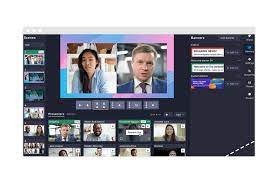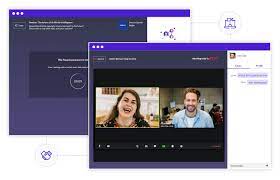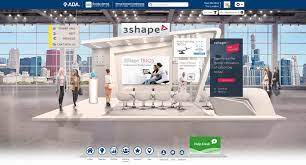Virtual Conference Solutions: Transforming the Way We Connect
In today’s fast-paced digital world, virtual conferences have emerged as a powerful alternative to traditional in-person gatherings. With advancements in technology and the need for remote collaboration, virtual conference solutions are revolutionizing the way we connect, communicate, and share knowledge.
One of the key advantages of virtual conferences is their accessibility. Attendees can join from anywhere in the world, eliminating the need for travel expenses and logistical challenges. This opens up opportunities for increased participation and engagement from a global audience. Whether you’re a small business owner, an industry professional, or an academic researcher, virtual conferences provide an inclusive platform to connect with like-minded individuals without geographical limitations.
Another significant benefit of virtual conference solutions is their cost-effectiveness. Organizing an in-person conference involves various expenses such as venue rentals, catering services, and travel arrangements. Virtual conferences eliminate these costs while still delivering a high-quality experience. Attendees can access presentations, panel discussions, and workshops from the comfort of their own homes or offices at a fraction of the cost.
Virtual conferences also offer flexibility in terms of scheduling. Traditional conferences often require attendees to block out several days on their calendars to accommodate travel time and event duration. With virtual conference solutions, sessions can be spread out over multiple days or even weeks to accommodate different time zones and individual schedules. This flexibility allows attendees to participate according to their availability without compromising on valuable content.
Engagement is crucial for any successful conference experience, and virtual conference solutions excel in this aspect as well. Through interactive features such as live chat rooms, Q&A sessions, and networking opportunities, participants can engage with speakers and fellow attendees in real-time. These platforms also enable seamless sharing of resources like presentation slides or whitepapers that enhance learning opportunities long after the event concludes.
Furthermore, virtual conference solutions often provide robust analytics tools that offer valuable insights into attendee behavior and preferences. Organizers can track metrics such as session attendance, engagement levels, and content popularity, helping them tailor future events to better meet the needs and interests of their target audience.
While virtual conferences cannot fully replicate the in-person experience, they offer numerous advantages and opportunities. As technology continues to evolve, virtual conference solutions will only become more sophisticated, providing an immersive and engaging environment for professionals across industries.
In conclusion, virtual conference solutions have transformed the way we connect by offering accessibility, cost-effectiveness, flexibility, engagement, and valuable analytics. As the world becomes increasingly interconnected digitally, virtual conferences are here to stay as a powerful tool for collaboration and knowledge-sharing. Embracing this innovative approach allows individuals and organizations to stay ahead in a rapidly evolving global landscape.
8 Advantages of Virtual Conference Solutions: Cost Savings, Convenience, Increased Reach, Environmentally Friendly Practices, Flexibility, Accessibility, Engagement Opportunities, and Scalability
- Cost savings
- Convenience
- Increased reach
- Environmentally friendly
- Flexibility
- Accessibility
- Engagement opportunities
- Scalability
6 Drawbacks of Virtual Conference Solutions: Limited Interaction, Technical Issues, Audience Engagement Challenges, Loss of Focus, Expensive Investment, and Security Risks
- Limited Interaction
- Technical Issues
- Difficulty Engaging Audience
- Loss of Focus
- Expense
- Security Risks
Cost savings
Cost savings: Embracing the Benefits of Virtual Conference Solutions
In today’s globalized and interconnected world, businesses are constantly seeking ways to optimize their operations and reduce expenses. One significant advantage of virtual conference solutions is the potential for substantial cost savings. By eliminating the need for travel, lodging, and other associated expenses, companies can allocate their resources more efficiently.
Travel costs can quickly add up when attending in-person conferences. From airfare to accommodation and meals, these expenses can strain a company’s budget. However, with virtual conference solutions, attendees can participate from the comfort of their own offices or homes. This eliminates the need for costly travel arrangements and allows businesses to redirect those funds towards other critical areas.
Lodging expenses are another aspect that can be significantly reduced through virtual conferences. In-person events often require attendees to stay in hotels or other accommodations near the conference venue. These costs can quickly accumulate, especially for multi-day events or when attending conferences in high-demand locations. By opting for a virtual conference, companies can eliminate these expenses entirely, freeing up valuable resources that can be reinvested elsewhere.
Associated costs such as meals, transportation within the conference city, and incidental expenses also contribute to the financial burden of attending traditional conferences. Virtual conference solutions remove these additional costs from the equation entirely. Attendees have the convenience of accessing sessions and networking opportunities without worrying about daily expenditures.
The cost savings achieved through virtual conferences extend beyond individual attendees. Companies hosting conferences also benefit from reduced overheads. Venue rentals, catering services, audiovisual equipment setup – all these aspects come with substantial price tags in traditional conferences. By transitioning to a virtual format, organizers can bypass these expenses altogether while still delivering an engaging and informative event.
Moreover, virtual conferences often offer flexible pricing options that cater to different budgets and needs. Attendees may choose between full access passes or select specific sessions based on their interests or professional requirements. This flexibility allows companies to tailor their conference participation to align with their financial capabilities without compromising on valuable content.
In conclusion, the cost savings associated with virtual conference solutions present a compelling reason for companies to embrace this transformative approach. By eliminating travel and lodging expenses, as well as reducing associated costs, businesses can optimize their budgets and allocate resources more strategically. As technology continues to advance, virtual conferences offer an efficient and cost-effective way for professionals to connect, learn, and collaborate. Embracing this trend not only saves money but also positions companies at the forefront of innovation in the ever-evolving business landscape.
Convenience
Convenience: Attend Anywhere, Anytime with Virtual Conference Solutions
In the era of virtual conferences, convenience takes center stage. One of the standout benefits of these solutions is the ability for attendees to join from anywhere with an internet connection, eliminating the need to worry about transportation or other logistical challenges.
Gone are the days when attending a conference meant booking flights, arranging accommodation, and navigating through unfamiliar cities. With virtual conference solutions, all you need is a computer or mobile device and an internet connection to participate in an event from the comfort of your own home or office.
This newfound convenience opens up a world of opportunities for both attendees and organizers. Professionals from different corners of the globe can connect and exchange ideas without the constraints of physical distance. Whether you’re in New York, London, or Tokyo, you can engage in insightful presentations, panel discussions, and networking sessions without leaving your desk.
The flexibility offered by virtual conferences is particularly beneficial for individuals with busy schedules. Traditional conferences often require attendees to commit multiple days to travel and onsite participation. Virtual conference solutions allow participants to access sessions at their convenience. Whether it’s joining live sessions or accessing recorded content later on-demand, attendees have the freedom to tailor their conference experience around their existing commitments.
Moreover, this convenience extends beyond just attending sessions. Virtual conferences often provide digital platforms that offer additional resources such as presentation slides, whitepapers, and discussion forums. These materials can be accessed at any time during or after the event, allowing attendees to revisit valuable content whenever they need it.
From an organizational standpoint, virtual conference solutions streamline logistics and reduce costs significantly. Without the need for physical venues or catering services, organizers can focus more on delivering high-quality content and engaging experiences rather than managing complex event logistics.
In conclusion, convenience stands as a major pro of virtual conference solutions. Attendees can participate in events from anywhere with an internet connection without worrying about transportation or other logistical hurdles. This flexibility not only saves time and money but also opens up opportunities for global collaboration and knowledge-sharing. Embracing virtual conferences allows individuals and organizations to connect, learn, and network conveniently, breaking down barriers and bringing people together like never before.
Increased reach
Increased Reach: Breaking the Boundaries of Location with Virtual Conferences
In the era of virtual connectivity, one of the most significant advantages of virtual conference solutions is their ability to break down geographical barriers and bring participants from different locations together in one virtual space. This feature opens up a world of possibilities and significantly increases the potential audience size for conferences.
Traditionally, attending a conference meant traveling to a specific location, often limiting participation to those who could afford the time and expenses associated with travel. However, with virtual conference solutions, anyone with an internet connection can join the event from anywhere in the world. This level of accessibility allows conferences to attract a diverse range of participants who may have otherwise been unable to attend.
The increased reach offered by virtual conferences holds immense value for both organizers and attendees. For organizers, it means being able to tap into a global pool of talent, knowledge, and expertise. They can invite renowned speakers and industry leaders from different corners of the world without worrying about travel logistics or visa restrictions. This not only enhances the quality of content but also enriches networking opportunities by bringing together professionals from various backgrounds.
On the other hand, attendees benefit from exposure to a broader range of perspectives and insights. They can engage in discussions with individuals who bring unique experiences and expertise that might not be readily available within their local communities. The diversity of participants fosters cross-cultural understanding and promotes global collaboration on shared interests or challenges.
The increased reach also has practical implications for industries that rely heavily on conferences for business development or showcasing products and services. Virtual conferences allow companies to reach potential clients or customers worldwide without having to invest in costly international marketing campaigns or physical presence at multiple events. This opens up new markets and expands business opportunities beyond borders.
Furthermore, increased reach enables knowledge dissemination on a larger scale. Researchers, academics, and subject matter experts can share their findings or present innovative ideas to a wider audience through virtual conferences. This democratization of knowledge benefits not only the participants but also society as a whole, as valuable insights and discoveries become accessible to a broader range of individuals.
In conclusion, the increased reach provided by virtual conference solutions is a game-changer in the world of conferences. By breaking down geographical barriers, these solutions create an inclusive and diverse environment that fosters collaboration, knowledge exchange, and business opportunities on a global scale. As technology continues to advance, virtual conferences will continue to redefine how we connect and learn, making the world a smaller and more connected place.
Environmentally friendly
Virtual Conference Solutions: Embracing Environmental Responsibility
In an era where sustainability is at the forefront of our minds, virtual conference solutions have emerged as a shining example of environmental responsibility. One significant advantage of these digital gatherings is their inherent eco-friendliness, as they eliminate the need for physical materials and travel associated with traditional events.
Traditional conferences often generate an enormous amount of waste, from printed programs and brochures to promotional materials that end up in landfills. By embracing virtual conference solutions, we can significantly reduce our ecological footprint. Attendees can access all necessary information digitally, eliminating the need for excessive paper usage. This not only saves trees but also reduces energy consumption and pollution associated with printing and transportation.
Moreover, virtual conferences eliminate the carbon emissions generated by travel. Traditional events require attendees to fly or drive to a specific location, contributing to air pollution and greenhouse gas emissions. By opting for virtual conferences, participants can connect from anywhere in the world without leaving their homes or offices. This reduction in travel not only decreases carbon emissions but also helps alleviate traffic congestion and lowers fuel consumption.
The environmental benefits of virtual conference solutions extend beyond the event itself. With no physical infrastructure needed for venue setup or teardown, there is a reduced demand for construction materials and resources. Additionally, ongoing maintenance and waste management associated with physical event spaces are eliminated.
By choosing virtual conferences over traditional ones, we make a conscious effort to protect our planet and preserve its resources for future generations. These eco-friendly gatherings align with our collective responsibility to combat climate change and reduce our impact on the environment.
As technology continues to advance, virtual conference solutions will only become more sophisticated and user-friendly. This presents an exciting opportunity for individuals and organizations to embrace sustainable practices while still fostering connections, sharing knowledge, and collaborating on a global scale.
In conclusion, virtual conference solutions offer an environmentally friendly alternative to traditional events by eliminating physical materials and reducing travel-related carbon emissions. By embracing virtual conferences, we can contribute to a more sustainable future while still enjoying the benefits of networking and knowledge sharing. Let us embrace this digital revolution and take a step towards a greener and more responsible world.
Flexibility
Flexibility: The Key Advantage of Virtual Conference Solutions
In today’s fast-paced world, time is a precious commodity. That’s why the flexibility offered by virtual conference solutions has become a game-changer for both organizers and attendees. By hosting conferences online, these innovative platforms provide greater freedom when it comes to scheduling and time management.
For organizers, virtual conferences eliminate the constraints of finding a suitable venue and coordinating travel arrangements for speakers and participants. With an online platform, sessions can be scheduled at different times to accommodate various time zones or individual availability. This means that attendees from across the globe can join in without worrying about conflicting schedules or travel logistics.
Moreover, virtual conferences allow organizers to extend the event duration beyond a single day. Instead of cramming all sessions into a tight schedule, they can spread them out over several days or even weeks. This flexibility ensures that attendees have ample time to engage with the content and participate in discussions without feeling overwhelmed or rushed.
From an attendee’s perspective, virtual conferences offer unparalleled convenience. With no need to travel or book accommodations, participants can join sessions from anywhere with an internet connection. This eliminates the stress and expenses associated with traditional conferences while maximizing productivity by minimizing time away from work or personal commitments.
Furthermore, virtual conference solutions enable attendees to personalize their experience by choosing which sessions they want to attend based on their interests and availability. They can easily navigate through the conference program and select the sessions that align with their professional goals or areas of expertise. This freedom allows individuals to optimize their learning experience and make the most out of their valuable time.
The flexibility provided by virtual conference solutions also extends beyond real-time participation. Many platforms offer on-demand access to recorded sessions, allowing attendees to revisit presentations or catch up on missed content at their convenience. This feature ensures that valuable knowledge is not lost due to scheduling conflicts or overlapping sessions.
In conclusion, one of the greatest advantages of virtual conference solutions is their flexibility in terms of scheduling and time management. By eliminating the constraints of physical venues and travel arrangements, these platforms empower both organizers and attendees to tailor their conference experience to their specific needs. Whether it’s accommodating different time zones, extending the event duration, or offering on-demand access to recorded sessions, virtual conferences provide the flexibility necessary for a truly convenient and efficient gathering of minds.
Accessibility
Breaking Down Barriers: The Accessibility Advantage of Virtual Conference Solutions
In the realm of conferences and events, accessibility has always been a challenge. Physical limitations, geographical boundaries, and language barriers often hinder participation for many individuals. However, virtual conference solutions have emerged as a game-changer in terms of accessibility, breaking down these barriers and opening up opportunities for people of all ages and abilities.
One of the key advantages of virtual conferences is their ability to transcend physical limitations. Individuals with mobility challenges or disabilities often face difficulties attending in-person events due to factors such as venue accessibility or travel constraints. Virtual conferences eliminate these obstacles by providing an inclusive platform that can be accessed from the comfort of one’s own home or office. Attendees can participate fully in sessions, engage with speakers, and network with fellow attendees regardless of their physical location.
Moreover, virtual conference solutions offer a variety of options that cater to different needs and preferences. Webinars and video conferencing software provide an interactive experience where participants can join sessions remotely using their computers or mobile devices. This flexibility allows individuals to engage with conference content at their own pace and convenience, accommodating busy schedules or time zone differences.
Geographical boundaries are no longer a limitation when it comes to virtual conferences. Attendees from around the world can connect seamlessly without the need for expensive travel arrangements or visa requirements. This global reach opens up new possibilities for networking, collaboration, and knowledge-sharing on an international scale.
Language barriers are also addressed through virtual conference solutions. Many platforms offer real-time translation services or provide session recordings with subtitles or closed captions in multiple languages. This enables participants who are not fluent in the conference’s primary language to fully understand and engage with the content being presented.
The accessibility advantage of virtual conference solutions extends beyond individual attendees to organizations as well. Companies can ensure that their teams across different locations have equal access to professional development opportunities by leveraging virtual conferences. This fosters employee growth and engagement, leading to a more skilled and cohesive workforce.
In conclusion, the accessibility offered by virtual conference solutions is a significant pro that cannot be overlooked. By eliminating physical limitations, geographical boundaries, and language barriers, these solutions empower individuals of all ages and abilities to participate fully in conferences and events. The inclusive nature of virtual conferences not only benefits attendees but also contributes to a more diverse and connected global community.
Engagement opportunities
Engagement Opportunities: Virtual Conferences Redefining Interaction
One of the standout advantages of virtual conference solutions is the enhanced engagement opportunities they offer. Unlike traditional events, where interactions are limited to physical presence and scheduled networking sessions, virtual conferences take engagement to a whole new level.
Through real-time chat functions, participants can actively interact with speakers, panelists, and fellow attendees throughout the conference. This instant communication fosters a dynamic environment where questions can be asked, opinions shared, and discussions sparked. Attendees no longer need to wait for designated Q&A sessions; they can engage with presenters and delve deeper into topics as they arise.
Additionally, breakout sessions in virtual conferences provide an avenue for smaller group discussions or workshops. Participants can join these specialized sessions based on their interests or objectives, allowing for more focused conversations and collaboration. These breakout rooms simulate the experience of intimate networking events or roundtable discussions that are common in traditional conferences but often limited by time constraints.
The interactive nature of virtual conferences also extends beyond the event itself. Many platforms offer post-conference forums or discussion boards where attendees can continue conversations and connect with like-minded individuals long after the conference concludes. This extended engagement ensures that the learning and networking opportunities persist beyond the event’s timeline.
Furthermore, virtual conference solutions often incorporate innovative features such as live polling or gamification elements that boost engagement levels. Attendees can actively participate in polls to gauge opinions or knowledge gaps within a session. Gamification elements like quizzes or challenges add an element of fun while encouraging active participation and knowledge retention.
By providing these diverse engagement opportunities, virtual conferences create an inclusive environment that encourages active participation from all attendees regardless of their location or background. The ability to interact in real-time breaks down barriers and fosters meaningful connections among professionals from various industries and regions.
In conclusion, virtual conference solutions excel in providing engaging experiences for participants through real-time interactions via chat functions and breakout sessions. By facilitating dynamic discussions, extending networking opportunities, and incorporating interactive features, virtual conferences redefine the traditional concept of engagement. As technology continues to evolve, these solutions will only become more immersive, enhancing the overall conference experience and driving meaningful connections among attendees.
Scalability
Scalability: Unlocking Limitless Possibilities with Virtual Conference Solutions
One of the standout advantages of virtual conference solutions is their scalability. Unlike traditional in-person conferences, virtual platforms provide the flexibility to easily accommodate a growing number of participants or make adjustments to the format based on specific needs.
In the world of conferences, scalability is a game-changer. With virtual conference solutions, you no longer need to worry about venue capacity limitations or logistical constraints. Whether you’re hosting a small gathering or planning for a large-scale event, these platforms can effortlessly scale up or down to meet your requirements.
Adding more participants to a virtual conference is as simple as sending out invitations and granting access to the online platform. There’s no need to worry about physical space limitations or additional costs associated with expanding venue capacity. Virtual conferences can accommodate an unlimited number of attendees from around the globe, enabling you to reach a broader audience than ever before.
Moreover, virtual conference solutions allow for seamless adjustments to the format based on your unique needs. You have the freedom to modify session durations, create parallel tracks, or even add new elements on-the-fly without disrupting the overall flow of the event. This level of adaptability ensures that your conference remains agile and responsive to changing circumstances or emerging opportunities.
Scalability also extends beyond participant numbers and event format. Virtual conference solutions offer customizable features and modules that can be tailored to suit your specific objectives. Whether you require interactive breakout sessions, networking lounges, exhibitor booths, or live streaming capabilities, these platforms provide the flexibility to incorporate various elements that enhance engagement and deliver an exceptional attendee experience.
Furthermore, as your organization grows and evolves, virtual conference solutions can effortlessly scale alongside your needs. Whether you’re hosting annual events or recurring webinars throughout the year, these platforms offer long-term scalability without requiring significant investments in infrastructure or resources.
In conclusion, scalability is a significant advantage offered by virtual conference solutions. The ability to easily add more participants or adjust the format according to your unique requirements opens up endless possibilities for hosting successful and impactful events. Embracing virtual conference solutions empowers you to reach a wider audience, adapt to changing circumstances, and deliver an exceptional conference experience that surpasses the limitations of traditional in-person gatherings.
Limited Interaction
Limited Interaction: The Challenge of Virtual Conference Solutions
While virtual conference solutions have undoubtedly revolutionized the way we connect and collaborate, it’s important to acknowledge that they do come with their own set of challenges. One significant drawback is the limited interaction compared to in-person events, which can make networking and collaboration more difficult.
In traditional conferences, attendees have the opportunity to engage in face-to-face conversations, build personal connections, and establish valuable professional relationships. The informal interactions during coffee breaks or networking sessions often lead to serendipitous encounters and meaningful collaborations. Unfortunately, virtual conferences struggle to replicate this level of personal interaction.
Virtual conferences typically rely on chat rooms, discussion boards, or video conferencing platforms for communication. While these tools facilitate some level of interaction, they may not fully capture the spontaneity and depth of in-person conversations. It can be challenging to recreate the energy and dynamics that come with meeting someone in real life.
Networking in a virtual environment requires more deliberate effort from participants. Without the ability to approach someone directly or strike up a conversation during breaks, attendees may find it harder to connect with like-minded professionals or potential collaborators. Building rapport through a screen can be more challenging than establishing it through face-to-face interactions.
Collaboration can also suffer in virtual conferences due to limited interaction. In-person events often foster an environment where attendees can brainstorm ideas together, work on projects collaboratively, or engage in group discussions effortlessly. Virtual conferences may struggle to provide the same level of synergy and collective creativity that comes from being physically present with others.
However, it’s important to note that organizers are continuously working on improving virtual conference solutions by integrating innovative features that encourage interaction and networking. For example, some platforms offer virtual lounges or breakout rooms where participants can engage in smaller group discussions or one-on-one meetings. Gamification elements are also being incorporated into virtual conferences to make them more engaging and interactive.
Despite the limitations, virtual conferences still offer valuable opportunities for learning, knowledge sharing, and professional development. They provide a platform for experts to share their insights, deliver presentations, and engage with a wider audience. Virtual conferences can be especially beneficial in situations where physical attendance is not feasible due to budget constraints or travel limitations.
In conclusion, while virtual conference solutions lack the personal interaction of in-person events, it’s important to recognize that they are constantly evolving. While they may not fully replicate the experience of face-to-face interaction, they offer unique advantages and continue to improve over time. By leveraging the available tools and actively participating in networking opportunities provided by virtual conferences, attendees can still make meaningful connections and collaborations despite the limitations.
Technical Issues
Technical Issues: A Challenge in Virtual Conference Solutions
While virtual conference solutions offer numerous advantages, it’s important to acknowledge that they are not without their challenges. One significant drawback is the potential for technical issues that can disrupt the smooth flow of an event and cause frustration among participants.
Poor internet connections are a common problem in virtual conferences. Despite advancements in connectivity, not everyone has access to a stable and high-speed internet connection. This can result in lagging audio or video, frozen screens, or even complete disconnections. Such disruptions can hinder effective communication and lead to missed opportunities for engagement.
Software glitches are another issue that can arise during virtual conferences. Even the most reliable platforms may encounter occasional bugs or compatibility issues with different devices or operating systems. These glitches can affect features like screen sharing, chat functionalities, or video playback, impacting the overall user experience.
Technical issues also pose a challenge when it comes to troubleshooting problems during a virtual conference. Unlike in-person events where technical support is readily available on-site, resolving technical difficulties remotely can be more complicated. Participants may need to rely on email support or online forums for assistance, which may not always provide immediate solutions.
Furthermore, the reliance on technology in virtual conferences introduces potential security concerns. Cybersecurity threats such as hacking attempts or data breaches can compromise sensitive information shared during the event. Organizers must ensure robust security measures are in place to protect participant data and maintain privacy.
Despite these challenges, it’s important to note that many of these technical issues can be mitigated with proper planning and preparation. Organizers should invest in reliable and tested platforms, communicate clear instructions to participants regarding technical requirements, and provide guidance on troubleshooting common problems.
Additionally, participants themselves can take steps to minimize technical disruptions by ensuring they have a stable internet connection before joining the conference, using compatible devices and software versions recommended by organizers, and familiarizing themselves with the platform’s features prior to the event.
While technical issues can be an inconvenience, it’s crucial to keep in mind that they are not exclusive to virtual conferences. Even traditional in-person events can encounter technical difficulties with audiovisual equipment or other technical setups. The key lies in being proactive, adaptable, and having contingency plans in place to address any unexpected challenges that may arise.
In conclusion, technical issues such as poor internet connections, software glitches, and security concerns can disrupt the smooth running of virtual conferences. However, with proper planning and participant preparedness, these challenges can be minimized. As technology continues to advance, we can expect virtual conference solutions to become even more reliable and seamless in the future.
Difficulty Engaging Audience
Difficulty Engaging Audience: A Challenge in Virtual Conference Solutions
While virtual conference solutions offer numerous benefits, one significant challenge that organizers face is engaging a remote audience. Unlike in-person events where participants are physically present in the same room, virtual conferences require innovative strategies to capture and maintain attendees’ attention throughout the event.
One of the primary reasons for this difficulty is the potential for distractions in a remote setting. Attendees participating from their homes or offices may be surrounded by various interruptions, such as phone calls, emails, or household responsibilities. These distractions can divert their focus away from the conference content, resulting in reduced engagement.
Moreover, the absence of face-to-face interaction can make it harder to establish a personal connection with participants. In physical conferences, speakers can gauge audience reactions and adjust their delivery accordingly. They can observe body language, make eye contact, and interact directly with attendees during Q&A sessions. However, in virtual conferences, these non-verbal cues are often limited or absent altogether.
Furthermore, virtual conference platforms may lack certain interactive features that facilitate engagement. While many platforms offer chat rooms and Q&A sessions, these tools may not fully replicate the dynamic atmosphere of an in-person event. The absence of real-time feedback and spontaneous conversations can hinder active participation and collaboration among attendees.
To overcome these challenges and enhance audience engagement in virtual conferences, organizers must adopt creative approaches. This could include incorporating interactive elements such as live polls or quizzes to encourage active participation. Engaging speakers who possess strong presentation skills and can captivate a remote audience is also crucial.
Additionally, leveraging technology to create immersive experiences can help maintain attendees’ attention throughout the event. Utilizing multimedia elements like videos or animations can add visual interest and keep participants engaged. Gamification techniques such as leaderboard rankings or rewards for active participation can also incentivize attendee involvement.
Organizers should also consider providing ample networking opportunities within virtual conferences. Facilitating virtual breakout rooms or dedicated networking sessions can help participants connect with each other, fostering meaningful interactions and knowledge sharing.
In conclusion, while virtual conference solutions offer numerous advantages, difficulty in engaging the audience remains a notable challenge. Overcoming this hurdle requires innovative strategies, interactive features, and engaging speakers to maintain attendees’ attention and active participation. By addressing these concerns head-on, organizers can create virtual conferences that are both informative and captivating, ensuring a valuable experience for all participants.
Loss of Focus
Loss of Focus: Maintaining Engagement in Virtual Conferences
Virtual conference solutions have undoubtedly revolutionized the way we connect and collaborate remotely. However, like any other technology, they come with their own set of challenges. One notable con of virtual conference solutions is the potential loss of focus for speakers due to the absence of a live audience.
In traditional conferences, speakers benefit from immediate feedback and interaction with their audience. The energy in the room, facial expressions, and body language of attendees all contribute to a dynamic and engaging presentation experience. This real-time feedback helps speakers gauge the level of interest and adjust their delivery accordingly.
In virtual conferences, however, speakers face a different environment. Without a physical audience present, it can be challenging to maintain the same level of engagement and connection. The lack of visual cues and direct interaction can lead to a sense of detachment and may impact the speaker’s focus during their presentations.
Additionally, without live feedback from attendees, speakers may find it difficult to gauge if their message is resonating or if they need to adapt their delivery style. This can result in a less dynamic presentation that fails to captivate the virtual audience as effectively as it would in an in-person setting.
To mitigate this challenge, organizers and presenters must be proactive in finding alternative ways to engage virtual attendees. Incorporating interactive elements such as live polls, Q&A sessions, or chat features can help bridge the gap between speakers and participants. Encouraging active participation through these tools can provide valuable feedback for speakers while fostering a sense of connection with the virtual audience.
Moreover, organizers should consider providing training or guidance to speakers on how to adapt their presentations for virtual environments. Techniques such as maintaining eye contact with the camera, using visual aids effectively on-screen, and utilizing storytelling techniques can help keep attendees engaged despite the lack of direct interaction.
It is important for both organizers and attendees to recognize that while virtual conferences offer convenience and accessibility, they require a different approach to maintain engagement. By acknowledging the potential loss of focus and actively implementing strategies to address it, virtual conferences can still deliver impactful and valuable presentations that captivate audiences.
In conclusion, the loss of focus due to the absence of a live audience is indeed a con of virtual conference solutions. However, with careful planning, interactive features, and speaker training, organizers can mitigate this challenge and create engaging virtual conference experiences that leave a lasting impact on attendees.
Expense
Expense: A Consideration in Virtual Conference Solutions
While virtual conference solutions offer numerous advantages, it’s important to consider potential drawbacks as well. One notable con is the expense associated with hosting an online event. Depending on the chosen virtual conference solution, there may be additional costs involved, such as purchasing software licenses and paying for streaming services.
Virtual conferences require reliable and feature-rich software platforms to ensure a smooth and engaging experience for attendees. These platforms often come with licensing fees, which can vary depending on the provider and the specific features required. While some solutions offer basic functionalities at lower costs, more comprehensive options may come at a higher price point.
In addition to software expenses, streaming services may also contribute to the overall cost of hosting a virtual conference. Streaming platforms are essential for delivering live presentations, panel discussions, and other content to participants in real-time. These services typically charge based on factors like the number of attendees or the duration of the event.
It is crucial for organizers to carefully evaluate their budgetary constraints when considering virtual conference solutions. Conducting thorough research and comparing pricing models of different providers can help identify options that align with financial limitations without compromising on essential features.
However, it’s worth noting that while there may be upfront costs associated with virtual conferences, they can still prove more cost-effective compared to traditional in-person events. The elimination of expenses related to venue rentals, travel arrangements, and catering services can offset some of these additional costs.
Furthermore, when considering the expense factor, organizers should also take into account potential return on investment (ROI). Virtual conferences can attract a wider audience from different geographic locations who might not have been able to attend an in-person event due to travel constraints or time commitments. This expanded reach can lead to increased brand visibility, networking opportunities, and potential business collaborations that may outweigh initial investment costs.
In conclusion, while expense is indeed a con of virtual conference solutions due to potential additional costs like software licenses and streaming services, it is essential to weigh these expenses against the benefits and potential ROI. Careful planning, budgeting, and exploring different pricing options can help organizers find a virtual conference solution that strikes the right balance between cost and value, ultimately providing a rewarding experience for both hosts and attendees.
Security Risks
Security Risks in Virtual Conference Solutions: Protecting Your Digital Gatherings
Virtual conferences have undoubtedly revolutionized the way we connect and collaborate, offering numerous benefits. However, it is essential to acknowledge that this innovative approach also comes with its own set of challenges, particularly in terms of security risks.
One of the primary concerns with virtual conference solutions is the potential vulnerability to security threats. Without proper security measures in place, virtual conferences can become targets for hackers or malicious actors seeking to exploit vulnerabilities and gain unauthorized access to sensitive information.
One common security risk is the possibility of hacking or unauthorized access to conference platforms. Hackers may attempt to disrupt sessions, steal confidential data, or even impersonate participants. This can lead to significant disruptions and compromise the integrity of the conference experience.
Data breaches are another critical concern. Virtual conferences often involve the exchange of sensitive information such as personal details, financial data, or intellectual property. If proper encryption and data protection protocols are not implemented, there is a heightened risk of unauthorized access leading to data leaks or misuse.
To mitigate these risks and ensure a secure virtual conference environment, organizers and participants must take proactive measures. Here are some key steps that can enhance security:
- Choose a reputable virtual conference platform: Opt for platforms that prioritize security and offer robust encryption protocols. Research their track record and ensure they have implemented necessary safeguards against potential threats.
- Secure access controls: Implement strong authentication mechanisms such as unique login credentials or multi-factor authentication to prevent unauthorized entry into conference sessions.
- Educate participants on best practices: Raise awareness about cybersecurity risks among attendees and provide guidelines on secure online behavior during the conference. This includes using strong passwords, avoiding suspicious links or downloads, and being cautious while sharing sensitive information.
- Regularly update software and systems: Keep all software applications up-to-date with the latest security patches to address any known vulnerabilities.
- Monitor for suspicious activity: Employ monitoring tools to detect and respond promptly to any unusual or suspicious behavior within the virtual conference platform.
- Secure data transmission: Ensure that all data shared during the conference is encrypted, both in transit and at rest, to protect it from interception or unauthorized access.
By implementing these security measures, organizers and participants can significantly reduce the risks associated with virtual conferences. It is crucial to prioritize security as much as convenience and accessibility when choosing and utilizing virtual conference solutions.
While security concerns exist, it’s important to note that with proper precautions, virtual conferences can still be a safe and effective way to connect and collaborate. By staying vigilant and proactive about cybersecurity, we can continue to leverage the benefits of virtual conferences while protecting sensitive information and maintaining the trust of participants.










